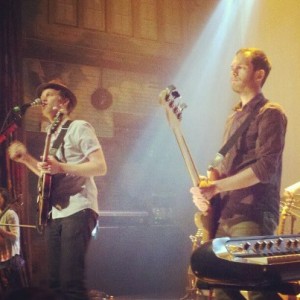The House of Blues creates a half-circle of barricades directly in front of the stage. It’s a small circle, but enough to keep the crowd in the center at bay. The Lumineers finish their first encore song, look at the barricades, and decide that barricades aren’t for them.
They hop right into the crowd, sending the security guards scrambling to keep up. The crowd obediently makes way for the band members to climb into the center of the packed room, instruments raised above their heads. The musicians scale chairs to be a little higher than the rest of the audience. Half the crowd is furiously waving an iPhone to take a photo of this moment.
“For this song and for all other songs,” shouts keyboardist Stelth Ulvang. “Put away your phones!”
The blue, glowing screens flicker off, giving way to darkness. The Lumineers, nearly sitting on top of each other and ready to lead the crowd into a song, don’t start until every phone disappears. Not a flash goes off, not a blue screen glows, just silence and darkness while the crowd waits — the band begins to play. Despite playing an acoustic song in the middle of a packed room, every note rings clear.
An indie-folk band out of Denver, The Lumineers have had a hell of a year. Wesley Schultz (guitar and lead vocals), Jeremiah Fraites (drums and percussion) and Neyla Pekarek (cello/mandolin) started as a self-supporting trio in the mountains, gracing the Meadowlark’s Tuesday night open mic. After their first single “Ho Hey” gained some radio play, the Lumineers signed to Dualtone, a record label known for respecting artists’ integrity and independence. “Ho Hey” broke Billboard’s Top 40 and made #1 on the Alternative Radio Chart. The last time the band played in New Orleans, they crammed into the Circle Bar. This time around, they’re in the main room at the House of Blues and readying to tour with Dave Matthews in December.
There’s a lot to be said for Schultz, the Lumineers’ leading man. He’s a talented guitar player who isn’t afraid to sing so hard that his voice breaks, and he likes to hold his guitar up to the mic so the audience can better hear the chords. His best moment of the night is a heart-warming cover of “Subterranean Homesick Blues.” Many Dylan fans in the audience sing with him, stomp their feet and clap to the frantic rhythm. While he’s no Bob Dylan (who is?), Schultz delivers a version that nearly matches the gritty, chaotic and ironic tone of the original.
The young band keeps the energy flowing, even through quieter songs like “Dead Sea” and “Slow It Down.” It helps that the audience knows most of the words, every tune turning into a sing-a-long. The band members enlist call-and-response techniques, which usually work out well in New Orleans. The touring keyboardist in particular frequently leaps on amps and seats, orchestrating the crowds’ vocals. The audience howls back the lyrics at the band. At one point, Schultz expressly encourages everyone to scream. The noise level reaches heights not usually seen at indie-folk shows. The audience loves it.
“We can hear you singing,” Schultz says in the middle of the show. He reminds the crowd that the band recorded the album in a humble home studio. “It means so much to us that you know the words to our songs–not just to [our single] ‘Ho Hey.’”
The members of the band switch instruments so easily that it seems like they simply spy an unused instrument and spontaneously snatch it up. Nearly all the Lumineers pick up the mandolin at some point. Two musicians back up the main trio (bassist Ben Wahamaki, keyboardist Ulvang), although “back up” doesn’t do justice to the talented Ulvang. Watching him thunder away on the keyboards during opener “Submarines” is among the show’s highlights.
Pekarek is the third of the Lumineers’ original trio, who joined the band after responding to Schultz’s Craigslist ad for a cello player. Her pitch-perfect voice earns wild applause every time she opens her mouth, and she steals the show’s last number, a cover of The Band’s “The Weight.” The back-up keyboardist, however, doesn’t take it lying down—for his solo, he shoves the mic with his head to make room for his hands, then lets loose on the keys while singing his heart out.
Some reviewers dismiss the unplug-your-instrument-and-walk-amongst-them technique—“It’s a novel idea, but one that has been done many times before and better,” sniffs Timothy Finn in The Kansas City Star. It works well in New Orleans, though, a city of music enthusiasts who love to be a part of the show and appreciate the closeness. Without any direction from the band, the audience claps with the beat, then realizes that for this experience clapping just doesn’t cut it. They stomp, the dull thud of a hundred pairs of feet hitting the wooden floor for a sound an amp will never be able to recreate.
Such a moment depicts why Lumineers live up to the hype—they have talent, they have energy, but more than anything, they have simple, sincere charm that shines throughout the night. The sweet ringing of Fraites’ xylophone weaves into the thudding, the singing, and the melody of the strings. The audience falls silent again as do the rest of the Lumineers. The only sound is the acoustic twitter of the tiny xylophone.





